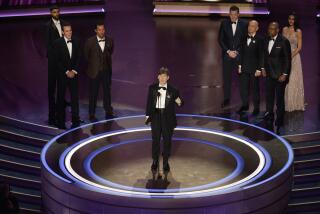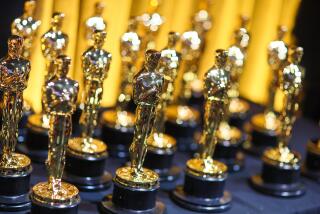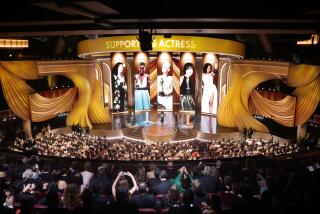And All That Money Goes to ...
Is Oscar turning into a billion-dollar baby?
During the last decade, escalating studio marketing campaigns have transformed Hollywood’s favorite awards ceremony into a high-stakes seasonal industry that stretches from early September, when hopefuls debut at the Toronto Film Festival, into the following spring, as companies chase their winners with self-congratulatory advertisements.
But calculating the financial effect of the Oscars has baffled even the experts. “Given the closed-mouth nature of this industry, you don’t get really good numbers,” said Jack Kyser, chief economist for the Los Angeles County Economic Development Corp.
Kyser has estimated that the Academy Awards contribute at least $61 million to the regional economy, boosting spending on services that range from limousine rentals to Botox treatments for stars.
Kyser concedes that his assessment is probably low, however, and says much of the Oscars’ value may come from a “nonquantifiable” glamour factor the ceremony brings to Los Angeles.
What’s more, the regional count ignores the reality that the Academy Awards is a global event with economic consequences that ripple across the country and overseas, from the box-office bump for some nominees and winners to the expected nationwide spike in takeout pizza sales on Oscar night, which will be March 23 this year.
Putting a hard dollar figure on such a far-reaching event is more guesswork than real accounting exercise. But an informed estimate of how much real economic muscle there is in Hollywood’s big night -- based on interviews, documents and a certain amount of informed supposition -- pegs Oscars-related activity at nearly $650 million annually.
Some players fret that awards-related spending may contract next year, when the Academy of Motion Picture Arts and Sciences plans to shorten the campaign season by moving its prize ceremony to late February.
But the overall Oscars economy appears poised to keep growing toward the billion-dollar mark, as studios and their expanding specialty film divisions, such as News Corp.’s Fox Searchlight or a unit to be launched this year by AOL Time Warner Inc.’s Warner Bros., push an increasing number of pictures into the race.
At present, the Oscars business adds up, very roughly, like this:
*
The academy’s piece:
$50.7 million
Fully 95% of the film academy’s operating budget last year came from the $47.4 million in income directly from the Oscars event, most of which was provided by Walt Disney Co.’s ABC network as a license fee for the awards telecast. According to the group’s annual report, $21.9 million went back into ceremony expenditures. An additional $8.9 million went to administrative expenses, and still more to educational and charitable activities.
But the academy’s take doesn’t stop with the fees. As of last June, the 6,400-member organization had tucked away almost $84 million in long-term investments, most of which came from previous Oscars shows. In 2001, a good year, it realized $8.4 million in gains; last year, which wasn’t good, it lost $1.8 million. In calculating typical financial fallout from the Oscars, it seems appropriate to average the two, which comes to $3.3 million. That gives a total of $50.7 million, even without counting the possible appreciation in the group’s Beverly Hills real estate holdings, bought largely with Oscars cash.
*
Studio spending:
$54 million
Film companies are tight-lipped about their spending on Oscar campaigns. But interviews with executives provide a credible framework for gauging overall marketing expenditures.
Campaign professionals say about eight films are typically backed by war chests of $3 million to $5 million each, while one or two, by tapping ad dollars from the film’s general release budget, can spend as much as $8 million. Back in the pack, they say, about a dozen campaigns are supported by about $1 million each, and the next 20 will pony up, say, $100,000 apiece.
Eight pictures at an average of $4 million yields $32 million. One wild card at $8 million bumps the total to $40 million. A dozen at $1 million pushes that number to $52 million, plus $2 million for all those also-rans, which brings the grand total to an entirely plausible $54 million.
And where does all that money go? The largest component of that spending, say insiders, is advertising in the Hollywood trade papers, which are regarded as the most efficient way of communicating with academy voters.
Publishers of both Variety and the Hollywood Reporter declined to disclose their Oscars-related ad revenues. But assuming the trades rely on the awards cycle for what insiders estimate is 35% of about $90 million in combined annual ad revenue, they would pull in $31.5 million.
Of the rest, much finds its way to the Los Angeles Times and the New York Times. A series of splashy, two-page Oscar-oriented ads in both papers would quickly add $5 million.
According to studio insiders, the balance gets scattered among expenses that only begin with mass mailings of tapes and DVDs to tens of thousands of actors, directors and writers who can influence Oscar choices. Private jets for traveling nominees can cost about $60,000 a pop. Outside publicity firms often are retained for $50,000 or much more.
A swank hotel such as the Four Seasons and its employees might take in an added $350,000 on Oscar weekend, much of it studio-funded. Limousine companies and drivers rake in maybe $1 million on the big night, with as much as half going to the six biggest limo companies, and again studios are big customers. Hairstyling, makeup, manicures and airline tickets help eat up what’s left.
*
The TV bonanza:
$70 million
This number is probably low, given the difficulty of counting the rupees, marks and yen spent on a telecast seen by a billion viewers worldwide.
“I wouldn’t know how to begin counting,” said one veteran TV executive when asked. Even Oscars pre-shows are broadcast abroad -- KABC-TV in Los Angeles, for instance, sells its own pre-show in 47 countries.
According to the most basic calculation, ABC has sold out its inventory of 58 half-minute Oscars spots for an average price of $1.35 million each, or a total of about $78 million.
Subtracting the $47 million or so already counted as a fee to the academy, that adds $31 million to the Oscars economy, even without tabulating the few spots sold by about 225 ABC affiliates during the awards program, or the dollars collected here and abroad by stations for various Oscars-related broadcasts.
Conservatively reckoning all that activity combined at just half of ABC’s gross Oscars income, or $39 million, pushes the TV tally up to $70 million.
* Movie revenue boost:
$400 million
Big-spending studios aren’t so much angling for prizes as for a payday at Oscar time. Recognition can translate into profit for pictures such as Miramax’s “In the Bedroom” -- a drama that took in $36 million in U.S. theaters but might have been overlooked without its five Oscar nominations and other honors last year. Nearly half of its U.S. box office was earned after its Oscar nominations were announced, in contrast with most films, which see the bulk of their take in the first few weekends.
So how much is the total Oscars bump at the box office?
“I’d be comfortable calling it $100 million,” said Paul Dergarabedian, president of theater consultant Exhibitor Relations.
But domestic ticket sales are only a beginning: Increased foreign ticket sales probably would kick in $100 million, while DVD, video and cable sales could easily add that much again, pushing the bump to $300 million.
And that’s not the end of it. It seems fair to argue that some of Hollywood’s more sophisticated pictures would never even be made if they couldn’t be sold against the awards hoopla.
Assume that just one film -- let’s say, “The Hours,” a heavily nominated drama from Viacom Inc.’s Paramount and Disney’s Miramax -- would have been tagged “too difficult” without the expectation of Oscar attention. Including anticipated revenue from all sources, that might account for $100 million in Oscar-related dollars, pushing the total movie bump to $400 million.
* Star perks:
$4.4 million
In one of the weirder Oscar rituals, designers such as Gucci, jewelers such as Christian Tse, spa goods makers such as June Jacobs, and many more line up to throw expensive gifts at the stars and their hangers-on. In fact, much of the stars’ on-screen glitter, from hairstyling and makeup to designer dresses, is either lent or given for free.
It’s all an exercise in “ambush marketing,” as companies hope to find themselves associated with winners on camera or in media reports. According to gift consultant Karen Wood, whose Backstage Creations is handling gifts for the Screen Actors Guild Awards ceremony, the Oscar-driven prize season generates at least 35 “gifting” situations with maybe five companies each providing goods with a retail value of $25,000 or more.
That means at least $4.4 million in gifts changes hands.
* In-town parties:
$3.5 million
Putting aside studio parties and the academy’s official Governors Ball, which are included in spending tallies above, the Oscars generate a cluster of expensive parties paid for by magazines and others trying to capitalize on the awards.
According to people involved with such affairs, a really big party, such as the annual Vanity Fair bash, can cost more than $1 million. Next-rung affairs at glitzy hotels such as Le Mondrian in West Hollywood may run $250,000. One veteran party person suggests counting at least 10 parties in the latter range, plus one big one, for a total of $3.5 million.
* Out-of-town parties:
$7 million
According to the academy, “hundreds of charity fundraisers” typically dovetail with the Oscar telecast. And the organization this year is helping promote those galas with “Oscar Night Parties” in 39 U. S. cities, where the sponsors mimic the Hollywood ceremony by arranging limo rides, red carpets, celebrity visits and so on.
It’s not unreasonable to guess that each party would cost $50,000 or more, adding $2 million to the total. If 200 more parties nationwide come in at just half that cost, the out-of-town party total rises to $7 million.
* Hollywood’s fluff-up:
$5 million
Leron Gubler, president of the Hollywood Chamber of Commerce, says the Oscars have had an enormous effect on Hollywood’s economic prospects since the ceremony’s return to the area last year. Not least of all, the academy helped give birth to the new Hollywood & Highland shopping mall by agreeing to hold the awards show in the center’s Kodak Theatre. “I would almost definitely say it would not have happened without the Academy Awards,” Gubler said of the complex.
Rather than wrestle with an imponderable “would the center even exist without the Oscars?” -- just credit the awards with 5% of the district’s recent growth in business receipts and value of assessed properties. That adds $5 million.
* The talent agency love fest:
$1 million
Hollywood’s talent agencies spend Oscar money too -- mostly on trade paper ads telling their winning clients how wonderful they are. One agency, which asked not to be identified, figures it spends about $250,000 on awards ads each year.
Assuming that Creative Artists Agency, William Morris Agency, International Creative Management, United Talent Agency and Endeavor play this game, along with several smaller agencies and management firms, it seems reasonable to allot at least $1 million for these love letters.
* The media swarm:
$1.4 million
The academy last year issued press credentials for “red carpet” access to 221 news organizations from around the world. Many organizations sent camera-toting crews of 25 people or more.
Reckoning the entire media swarm at an extremely conservative 700 people, and assuming they spent an impossibly modest $2,000 each on food, lodging and equipment during their stay, the media contingent would contribute $1.4 million.
* Munchies:
$25 million
Americans spend an average $1.2 billion each day dining out, the National Restaurant Assn. says. With nearly 42 million fans watching the Oscar telecast, a conservative guess says 5% fewer people are going out to dinner that night. So let’s subtract 5%, or $60 million, from the nationwide restaurant spending total.
But nearly 50% of normal restaurant spending consists of pizza deliveries and other fast-food or takeout food, the trade group says. And the 7,000-store Pizza Hut chain, for one, “does see our business increase anytime the country is gathered in front of the television like this,” spokeswoman Patty Sullivan said. Assuming a one-night spike for pizza and other home-delivered food, we’ll add back $5 million for extra pepperoni pies and bags of Chinese food, reducing the restaurant hit to $55 million.
That reduction only partially offsets what appears to be a boost in Oscar night grocery sales. Assume just 10% of the ceremony’s viewers, or 4 million people, each buy an average $20 of extra beer, soda, nachos, popcorn and other treats to make the telecast more bearable. That would add back $80 million in grocery sales and offset the loss in the restaurant sector, for a net food gain of $25 million.
* The big-screen-TV bump:
$21.5 million
OK, it’s show time and we’ve got our pizza and pretzels. And luckily, we’re among those consumers who sprang for a big-screen TV to watch this year’s nominees. Indeed, the Oscars ranks with the Super Bowl as a reason people buy a TV the size of a minivan.
“The Oscars for us always has meant a big bump in sales,” says Paul (“I am the king!”) Goldenberg, owner of Paul’s TV in La Habra, a leading retailer of big-screen sets. “We probably have at least a 10% increase due to the Oscars” compared with a typical month, he says, noting most of his sets retail for $2,500 to $3,500.
Now, the Consumer Electronics Assn. forecasts that 4.3 million big-screen TVs will be sold nationwide this year. Let’s suppose Goldenberg gets an especially big boost because he’s “the king” and services the Los Angeles area; so we’ll give the nationwide industry just a 2% volume increase from the Oscars for the month. That’s 7,167 sets at $3,000 apiece, or $21.5 million in added sales.
* The bottom line:
$643.5 million
Ka-ching!
More to Read
The biggest entertainment stories
Get our big stories about Hollywood, film, television, music, arts, culture and more right in your inbox as soon as they publish.
You may occasionally receive promotional content from the Los Angeles Times.











